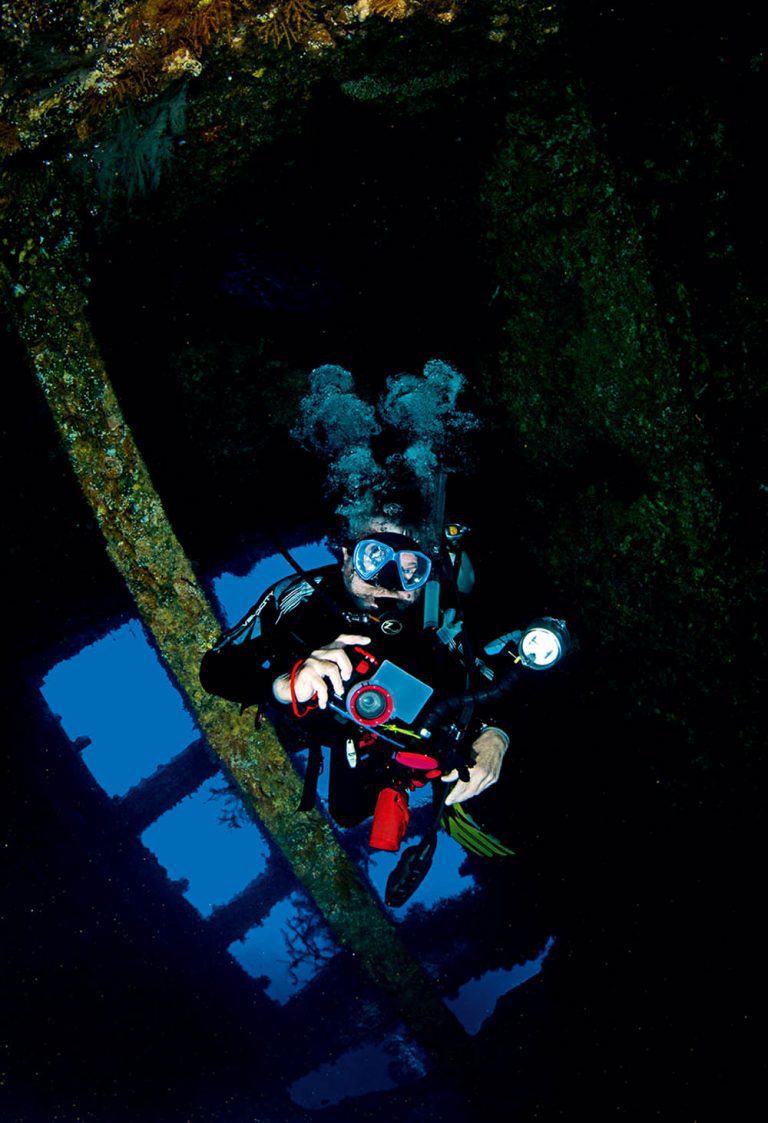RED SEA DIVER
Never Mind The Season
Liveaboard diver MARK B HATTER had enjoyed a Red Sea itinerary in summer and, despite initial mild thermal shock, was also braced by a complementary winter experience. You can’t go wrong!
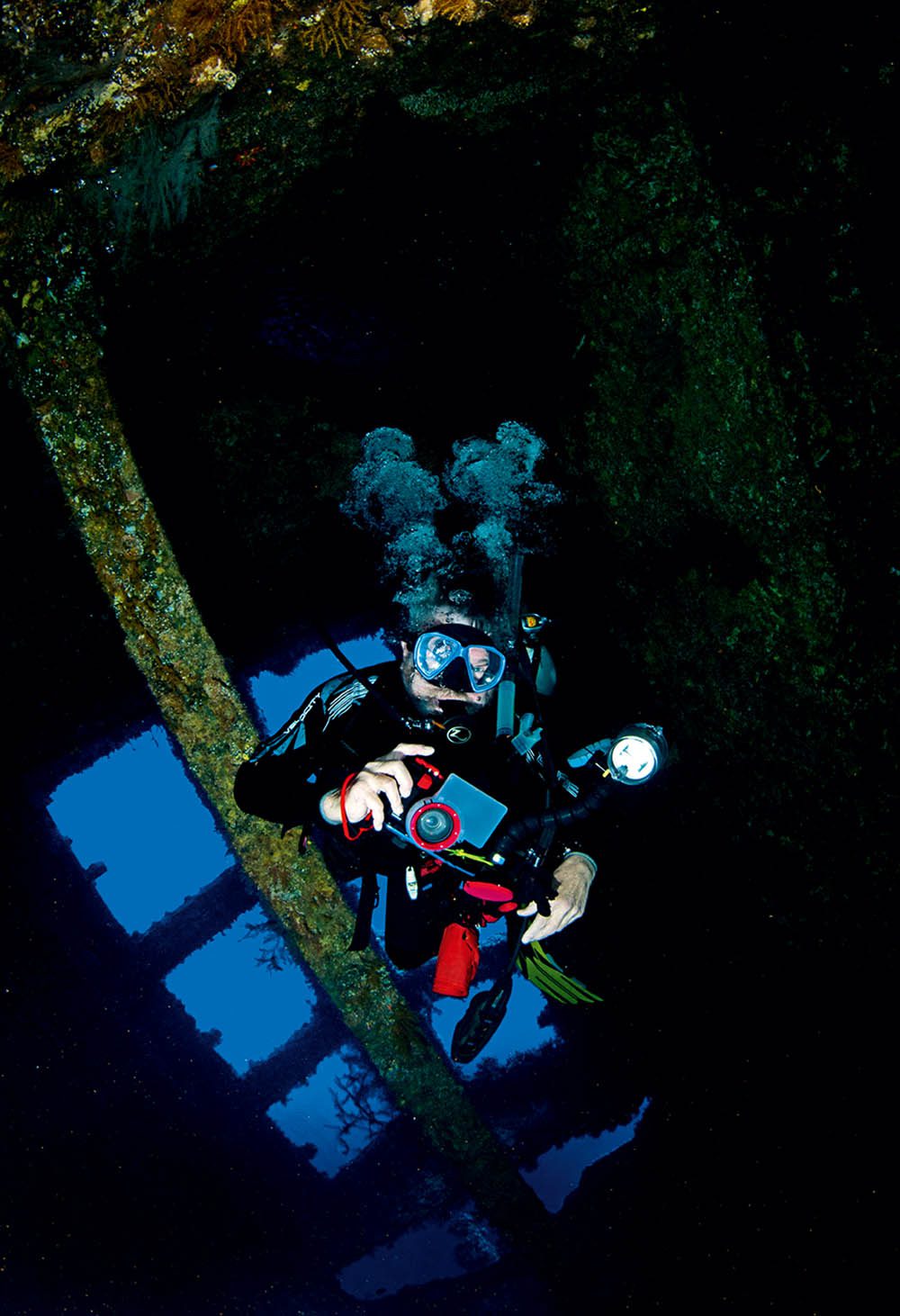
Diver Bill Paskert inside the Numidia wreck at Big Brother.
Appeared in DIVER September 2019
A trickle of 22°C water leaked between my 5mil wetsuit and my spine, sending a shiver though my body. True, the water was much warmer than the 16°C air, but still dramatically different from the last time I was here in July, 2015, when the air felt like a sauna and the 28°C sea surface was like bathwater.
Who knew that the Red Sea could get this cold in the middle of winter?
I settled to 5m, checked my kit and fired a thumbs-up to my diving buddy, Chris Dascher, a few metres away.
Chris had dived with me on our July trip and, like me, had been eager to escape the North American winter to sample the Egyptian Red Sea’s sub-tropical climate for a second time.
Which was why he too had been surprised by the brisk environment. Apparently, our preconceived idea of warming our winter bones in the Red Sea needed an adjustment.
And while I might have been snivelling just a bit, the coral-rich reef residents of Daedalus Reef in the middle of the Red Sea seemed perfectly happy in the raw water, thank you very much.
We had rolled off the inflatable with our small group of divers just off the famous anemone wall along the south-western flank of Daedalus. The wall is vertical and drops from the surface to more than 1000 m.
A colonial forest of beautiful Heteractis magnifica anemones, fluorescing yellow-green tentacles against impossibly magenta bodies, stretches from the surface to nearly 20m.
The last time we dived there juvenile three-spot damselfish, Dascyllus trimaculatus, had outnumbered by nearly two to one the true anemone symbionts, Amphiprion bicinctus, subjects of our photo obsession.
“Photo-bombers!” I remember complaining to myself in the summer of 2015 while trying to shoot the proper hosting anemonefish between the flitting fish that looked more like moving dominoes.
And now, here they were again, out in force in the winter of 2019.
I have respectable images of Daedalus’s hosting anemonefish, sans the three-spots, from my last trip but I can always do better and was looking for something more artistic for the coffee-table book on the subject of the world’s anemonefish that I hope to write some day.
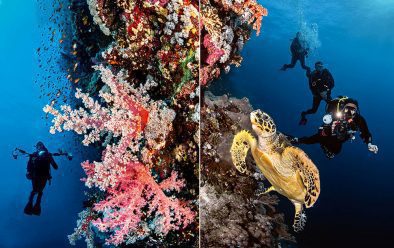
The cliche regarding patience being a virtue was the watchword, and Chris and I would spend the entire dive on the anemone wall, looking for that David Doubilet-quality image, somewhere between the army of swirling damselfish.
At 60 minutes, the insulation our 5mil suits provided was simply not enough to allow us to comfortably continue shooting between the orbiting damselfish.
So we moved off the wall, allowing the brisk current to pull us back toward the Red Sea Aggressor II, moored in the lee of Daedalus’s northern flank.
The fact that Chris and I were able to spend the entire dive alone on the anemone wall was not lost on either of us.
The divemasters on Red Sea Aggressor II had given us wide latitude on our first trip in 2015, and had extended the same courtesy on this most recent excursion.
Which was a key reason why we had booked the RSAII for a second time.
That, and the value of the exchange rate between the Egyptian pound and both US dollars and sterling, make the liveaboard’s weekly itinerary one of the most affordable trips in the world.
The Red Sea Aggressor II books three operational routes out of Egypt’s Port Ghalib. The northern route encompasses the Brothers Reef complex, Daedalus and Elphinstone Reefs and a smattering of local dives along the eastern shore of Egypt’s desert near Port Ghalib.
The southern route also includes Daedalus and Elphinstone but also travels south to the St John’s Reef complex and eastern shore sites along the way back north to Port Ghalib.
Both circuits are seven-day bookings, typical for Aggressor Fleet boats, with five-and-a-half days of diving and up to four dives a day (including the night dive).
A few times a year a 10-day trip is offered, encompassing both itineraries in one journey.
Because Chris and I had completed the northern route in July 2015, this winter trip to the south would provide a perfect bookend to our Red Sea Aggressor II adventure.
The Red Sea’s popularity and ease of access for Europeans is well known. Scores of day-boats and liveaboards operate out of every supporting port along Egypt’s eastern coastline, and vessels can stack up at popular sites such as the Brothers and Elphinstone.
Even today, the diving can get crowded. But it seems that February could be a better time to visit if you’re not averse to rougher conditions, donning a thicker suit for insulation and able to manage cool, winter air on deck between dives.
When winter reaches the Red Sea it brings both a cost (comparatively harsher conditions) and a benefit (fewer boats, fewer divers).
I wish I hadn’t waited until 2015 to make my first visit to the Red Sea. Despite the summer crowd of divers from other boats we shared on our northern-route dive-sites, it was pleasing to find every reef we visited in beautiful condition.
I’m sure that “beautiful condition” is a relative term, and those who have been diving the Red Sea for decades could argue the point, but from my observations and perspective many parts of the offshore dive-sites seemed to have near-pristine environments in 2015, at least as my initial benchmark.
Having dived both Elphinstone (my favourite site) and Daedalus following that four-year hiatus, I found no discernible difference in the reef environment.
This was evidenced by the still-remarkable old-growth coral coverage near the reef crowns, the prolific soft-coral formations along the outer walls, and the shoals of colourful reef fish.
Any site regularly bathed by strong currents, a key factor in maintaining healthy corals, appeared unchanged.
I find this remarkable considering the diver traffic these sites experience throughout the year.
The popularity of the Red Sea as a dive-destination appears to offer the advantage to a shooter that marine subjects become accustomed to the constant presence of divers, and so are less shy.
Many of the reefs along the RSAII routes offer the possibility of encounters with large animals such as Napoleon wrasse, turtles, mantas, marine mammals and even sharks, which Chris and
I experienced as having a higher tolerance for our presence than in more remote places we’ve visited.
Daedalus is typically the first major venture after the requisite afternoon checkout dives just outside Port Ghalib. It’s a six-and-a-half-hour steam to Daedalus, accomplished overnight.
The anemone wall can be dived year-round, and the warm, summer water-column attracts scalloped hammerhead sharks, which school off Daedalus’s south-eastern flank, 50m or more off the wall.
The dive is essentially made in blue water, typically out of the visibility of the reef wall and deeper than 20m.
The sharks are curious and often come in for at least a drive-by, if not staying
to mingle with the divers for several minutes. Each dive we made specifically for the sharks delivered.
Whether shooting anemonefish or sharks, the dives are planned to drift divers back toward the boat moored in the lee of the prevailing current.
Along the way, you can often find turtles, Napoleons, the occasional manta and other reef critters, some endemic to the Red Sea.
While the hammerheads vacate Daedalus in winter, oceanic whitetip sharks appreciate the cooler water and are occasional visitors to the offshore reefs during the winter months. But while Chris and I scored with the hammerheads, the oceanics we had hoped to see on our winter visit were missing in action.
The Brothers was our next stop, a pair of undersea mounts rising from the depths to breach the surface about eight hours north-west of Port Ghalib. With the diversity of diving offered around the twin peaks, the RSAII generally allows two days to explore.
Big Brother hosts all manner of diving opportunities, from slopes to vertical walls to wrecks and plateaus.
Two of the more popular dives are a pair of wrecks on the northern reef, where strong currents dominate, but if the crew can plan accordingly, the dives can be made on slack tides. During our summer visit the team planned it perfectly, and we were able to dive both wrecks.
The Aida, a 75m transport supply ship that crashed into the reef in 1957, is the easier but also the deeper of the two wrecks to dive along the northern reef slope. It begins at 30m, where the bow rests, and falls away to 60m.
We had stellar visibility, making it that much more difficult to leave the wreck when our bottom-time expired.
The Numidia is a more formidable wreck in shallower water, large enough to penetrate if you are appropriately trained. It begins at 8m and falls down the steep slope to 80m.
Again, we timed the tides beautifully and were able to dive not only the exterior but to penetrate one of the holds before time and currents chased us back to the surface.
Teardrop-shaped Little Brother sits 500m south of its sibling and offers divers vertical walls and a gentle slope on the northern flank.
The slope is famous for its silvertip sharks, but I suspect the number of divers we experienced on the slope from other vessels kept them deeper than we could dive. However, a very curious and quite large Napoleon wrasse seemed indifferent to the crowds and delighted our group by flying wingman with us for most of the dive.
On the southern itinerary, the St John’s Reef complex follows diving at Daedalus, a 10-hour steam south.
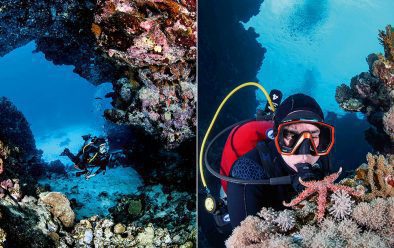
Straddling the Tropic of Cancer, this is as far as the Red Sea Aggressor II sails. It is characterised by shallow plateaus with large caverns and tunnels in the reef structure, giving the sites a cathedral-like experience.
Coral bommies are abundant, many towering up from 20m to the surface, layered horizontally with great slabs of tabling hard corals. Here too, the ubiquitous and fearless Napoleon wrasse accompanied our divers at most sites.
In mid-week the Red Sea Aggressor II turns back north and visits a number of unique sites.
Most memorable was a morning spent snorkelling with a large pod of spinner dolphins at remote offshore seamount plateau Fury Shoals, which levels off at 10m to an expanse of white-sand bottom behind a protective shallow reef.
Like the other large denizens of the Red Sea, these mammals have had significant interactions with humans, turning them “snorkeller-friendly” and perfect subjects for wide-angle, available-light shooting if they’re in playful mood.
Luckily for us, they were. Kitted up with wetsuits and snorkels (weights to attain neutral buoyancy are not allowed), we swam with the pod for the better part of two hours until our legs gave out from fin fatigue.
The iconic Elphinstone Reef will be your final destination, and in my opinion it’s the best way to cap a week’s Red Sea diving.
This cigar-shaped seamount runs north-south for 400m near Marsa Alam, just off the coast. It was named after a British naval commander who served in Egypt during the Napoleonic Wars in the early 1800s.
I had found Elphinstone spectacular in 2015, with perhaps the best visibility I’ve witnessed. I vividly recall my first dive, dropping to 40m at the southern end of the reef and shooting up the slope to a small group of divers seemingly just below the surface.
So clear was the water that backscatter in my images was non-existent, and the sharpness of distant subjects remarkable.
As I ascended the slope and then drifted along the wall, moving up gradually on my computer’s advice, I was awestruck by the brilliance of the soft corals and then the stony plating corals just beneath the surface.
Chris and I lingered for as long as our gas-mix allowed on that final dive, as I had hoped to repeat that experience on our winter journey. Alas, colder water brings more nutrients and reduced visibility.
Still, at nearly 30m the water clarity remained impressive, and the legions of anthias hovering above magnificent old-growth tabling corals near the surface seemed to enjoy the nutrient-rich water more than I remembered from that summer’s dive.
With the opposite tide cycle, we were able to explore the plateau on the northern end of the reef, which had not been possible on our summer trip.
The plateau proved epic, with a dense forest of soft corals at 30m and a flourish of the Red Sea-endemic Anthias taeniatus.
It’s the end of the week, the air is still crisp, the water cool and I’ve lost more than a few pounds as my body burned fuel to stay warm.
I’m content now, at the computer, processing images, and think about the Red Sea Aggressor II itinerary I have yet to book.
The Red Sea deserves more effort on my part to shoot its colourful story and I can still improve on my anemonefish images. It seems appropriate, then, to begin planning for that 10-day itinerary…
FACTFILE
GETTING THERE> Egypt Air flies daily from London Heathrow to Hurghada. Aggressor can arrange a road transfer to Port Ghalib.
DIVING & ACCOMMODATION> Red Sea Aggressor II (and several other liveaboards) operate from Port Ghalib with weekly charters for up to 20 divers. Bookings include food, beer and wine. Nitrox is available, aggressor.com
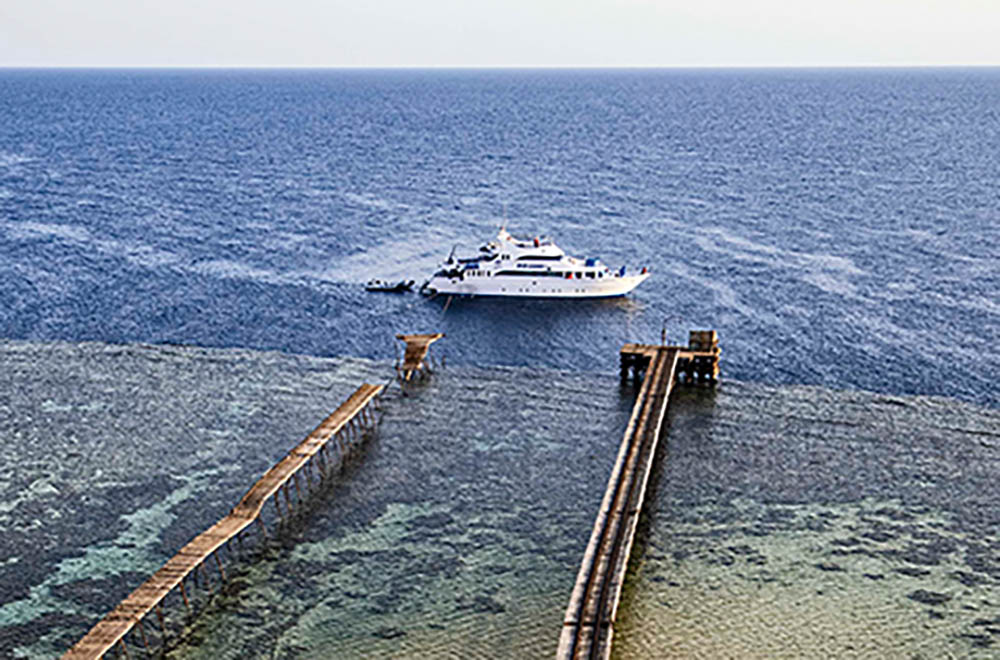 WHEN TO GO> Year-round but the warmest, calmest conditions coincide with summer and autumn, when water temperatures are around 28°C. In winter, water temperatures can fall to 22°C and it can be windy and cool.
WHEN TO GO> Year-round but the warmest, calmest conditions coincide with summer and autumn, when water temperatures are around 28°C. In winter, water temperatures can fall to 22°C and it can be windy and cool.
MONEY> Egyptian pound but credit cards recommended.
HEALTH> Nearest hyperbaric chamber is in Marsa Alam.
PRICES> For a seven-day charter, the Red Sea Aggressor II currently costs about £1000pp. Return flights from around £650.
VISITOR Information> egypt.travel
